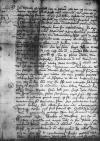Iam destinata est profectio mea in ⌊Poloniam⌋. Alia enim negotia orig. negocia⌈negotianegotia orig. negocia⌉ non obibuntur,[2] propterea quod ab ⌊Anglis⌋ nihil metuimus. Mutata est in totum ⌊illorum⌋ sententia et qui prius bellum voluere, iam pacem desiderare orig. desyderare⌈desideraredesiderare orig. desyderare⌉ coguntur. Soli sunt ⌊rex⌋ ⌊cardinalis⌋que, populus miru written over e⌈euu written over e⌉m, quam ⌊caesari⌋ favens. Si semel eo arma converteremus, protinus videre orig. viderae⌈viderevidere orig. viderae⌉ esset omnia nostra. Magno bono suo abstinet uterque. Ibo ergo propediem, hoc est intra decem dies. Nam hactenus protracta res est consultationibus, cum determinandum esset, quid de ⌊Anglis⌋ dicendum esset. ⌊Campiductor⌋ noster magnus ille et insignis adhuc ⌊apud Brabantos⌋ versatur, nisi forsitan intra quattuor ab hinc dies abierit. Nam cum haec scribo, ⌊Brugis⌋ versor in eo negotio orig. negocio⌈negotionegotio orig. negocio⌉ impeditus, quod mihi nosti cordi esse[3] et procedit belle, immo ad extrema fere perventum est. Cum ex ⌊Polonia⌋ rediero, tum finis erit huic catastrophae. Redibo tamen ad vos, nam id non impediet. Maior est enim utrobique virtutis honestique, quam aliarum rerum ratio. Sed haec hactenus.
In ⌊Germania⌋ mire tumultuatur. Nam cum statuisset ⌊Ioachimus marchio Brandeburgi⌋ ⌊coniugem⌋ suam, sororem ⌊Christierni regis⌋, aut igni tradere aut intra quattuor parietes inclusam fame enecare ob susceptum, ut ille ait, Lutheranum dogma,[4] neque iam clam essent minae, illa sese nocte intempesta subduxit fugitque in ⌊Saxoniam⌋ ad ⌊avunculum⌋. Hinc bellum Troianum: repetitur coniunx, negatur. Genus belli par, causa impar. Nam illa aut superinscribed⌈autaut superinscribed⌉ sponte aut rapto ⌊Paridis⌋ sane forma capta fugit, haec metu mortis et instantis periculi coacta est sibi consulere. Hinc ergo ⌊maritus⌋ cum ⌊fratre Moguntino⌋, illinc ⌊Saxo avunculus⌋ cum ⌊lantgravio Hassiae⌋. Iam collecta sunt hinc inde aliquot milia equitum. Nescio, quis finis futurus est. Scribam ad te copiose cum in ⌊Germaniam⌋ pervenero. Nam hic ad manum non sunt characteres nostri,[5] mansere enim ⌊Machliniae⌋, quo ego iam iam festino.
Commenda me amicis omnibus et ⌊seni⌋ subinde per occasionem v written over ...⌈... illegible⌈...... illegible⌉vv written over ...⌉eterem consuetudinem obtru{n}des
. Nam ego ad ⌊illum⌋ scripsi ex te intellecturum esse alia quaedam de rebus meis, quae tu pro tempore et oportunitate facile poteris recensere. Si quid interim vacat, quod in rem meam sit, poteris
 BCz, 243, p. 88
amici munere fungi. Si quid etiam sit, quod ad tuos scribas, fac, me illis commendes. Illustrissimo domino marchioni(!) instead of Illustrissimum dominum marchionem⌈Illustrissimo ⌊domino marchioni⌋(!)Illustrissimo domino marchioni(!) instead of Illustrissimum dominum marchionem⌉ meo plurimum nomine saluta adiunctis triginta milibus bezolas manus. Quarum decem milia altera ⌊Ioannes Anthonius Marlianus⌋ sibi habeat, totidem ⌊tua⌋ et frater tuus ⌊Bernardus⌋. Nuntius orig. Nuncius⌈NuntiusNuntius orig. Nuncius⌉ Mariae[6] d written over c⌈cdd written over c⌉uplum harum sibi retineat. Itaque omnibus has ex aequo impartire. Et vale frater amantissime.
BCz, 243, p. 88
amici munere fungi. Si quid etiam sit, quod ad tuos scribas, fac, me illis commendes. Illustrissimo domino marchioni(!) instead of Illustrissimum dominum marchionem⌈Illustrissimo ⌊domino marchioni⌋(!)Illustrissimo domino marchioni(!) instead of Illustrissimum dominum marchionem⌉ meo plurimum nomine saluta adiunctis triginta milibus bezolas manus. Quarum decem milia altera ⌊Ioannes Anthonius Marlianus⌋ sibi habeat, totidem ⌊tua⌋ et frater tuus ⌊Bernardus⌋. Nuntius orig. Nuncius⌈NuntiusNuntius orig. Nuncius⌉ Mariae[6] d written over c⌈cdd written over c⌉uplum harum sibi retineat. Itaque omnibus has ex aequo impartire. Et vale frater amantissime.
 BCz, 243, p. 88
amici munere fungi. Si quid etiam sit, quod ad tuos scribas, fac, me illis commendes. Illustrissimo domino marchioni(!) instead of Illustrissimum dominum marchionem⌈Illustrissimo probably
BCz, 243, p. 88
amici munere fungi. Si quid etiam sit, quod ad tuos scribas, fac, me illis commendes. Illustrissimo domino marchioni(!) instead of Illustrissimum dominum marchionem⌈Illustrissimo probably 

